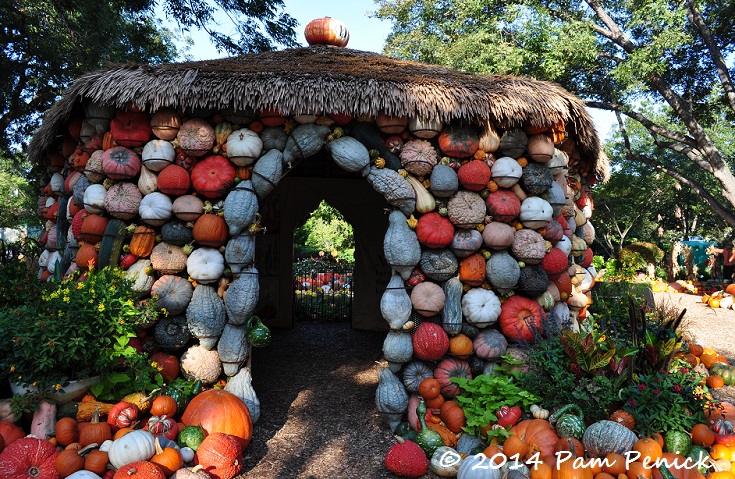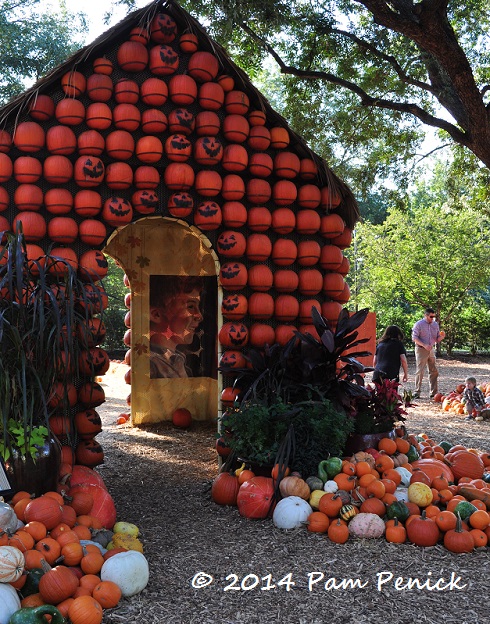Pumpkin extravaganza at the Dallas Arboretum
The Dallas Arboretum goes pumpkin crazy each fall.
Last Sunday we visited to see their over-the-top Pumpkin Village, in which a whopping 65,000 pumpkins, gourds, and squash are used to create play houses, line paths, and fill a pumpkin patch that would make Linus proud.
The pumpkin houses are fun for kids and adults alike.
Metal rings on the walls hold an assortment of pumpkins and squash.
More are piled around the doorways in artful displays.
Interiors are decorated with strings of tiny pumpkins along thatched ceilings and printed children’s stories on the walls.
As in in any proper village, the houses have unique designs. This one is all orange pumpkins.
Spray-painted jack ‘o lantern faces on some add a little spooky fun.
But not too spooky
This is a smart way to decorate pumpkins in the South, where those carved too soon collapse in on themselves in the heat.
This house is truly child-sized. Potato vine spills across the roof like a fairy tale beanstalk.
A fenced pumpkin patch guarded by friendly scarecrows contains pumpkins grouped by type — and there are so many varieties! Hand-lettered signs tell you what each type is called.
Boo!
Cinderella’s carriage, pulled by horses made of cornhusks and other natural materials (sorry, my pics didn’t come out), sits near a pumpkin patch filled with blue-painted and white pumpkins. I like how the sprawling sweet potato vines stand in for pumpkin vines.
Pumpkins also transform into sunflowers!
I think these are adorable.
Indian corn and tiny pumpkins are festively strung between trees.
How do they do it? Copper wire wraps the pumpkins and corn and secures them to a steel cable.
Stacked pumpkins, like Halloween totem poles, add structure to beds of colorful marigolds.
Orange marigolds echo the pumpkins’ shape and color.
A statuary cornucopia is surrounded by a real-life one.
Orange pumpkins beyond count line the paths.
White pumpkins take over by the Alex Camp House to match the white brick.
The front porch display features white pots filled with fall annuals and more pumpkins.
This is an unexpected and fun combination: golden shrimp plant and Persian shield, with more pumpkins along the walk.
I also love this vignette, though I don’t know what the plants are.
Just look at the size of those pumpkins!
Piles of pumpkins, squash, and gooseneck gourds adorn the entry garden.
The gift shop is getting in on the action too.
If you want to bask in the pumpkin glory, the Pumpkin Village will be on display until November 26. (I hated to see it so early, but they’re also already putting up the Christmas display, which opens November 16.) The Arboretum is offering early admission hours on weekends through the end of October: 8 a.m. for visitors and 7 a.m. for members. And if you’re a member of the Lady Bird Johnson Wildflower Center, you’ll enjoy reciprocal free membership at the Dallas Arboretum!
Up next: Monarchs flutter into Dallas Arboretum on their fall migration
All material © 2006-2014 by Pam Penick for Digging. Unauthorized reproduction prohibited.

































They outdid themselves this time. I seem to remember a post last year about this event. What fun, and lots of ideas to put into use on a much smaller scale.
You have a good memory, Ricki. I posted about the Arboretum’s Pumpkin Village 3 years ago. —Pam
Oh to have the pumpkin contract for the Dallas Arboretum. It really is a marvelous display and really draws the crowds. Enjoyed by young and old alike.
You’re right, Jenny. The pumpkin suppliers must make a fortune! —Pam
Only one comment … “BOO!”
Eek! —Pam
I am always amazed at your pictures of this event. They sure do make it a pumpkin heaven.
It’s astonishing to see what they come up with, Lisa. I wonder how long it takes them to set it all up? —Pam
What a treat…I have always wanted to see this holiday display.
It is a lot of fun, Donna. I hope you get to visit and see it sometime. —Pam
This makes me smile. Isn’t it wonderful how creative people can be.
Yes, indeed! —Pam
As much as I appreciate the energy, ingenuity and organization needed to pull something like this off I am left feeling really uncomfortable. How much water was used to grow these pumpkins … how much land was devoted to a temporary display … Texas is still in a state of drought and the NY Times recently reported that about 40% of the kids in Texas live in poverty. The majority of urban kids are eligible for free or reduced lunch plans because their families don’t earn enough to keep them fed.
Your concerns are shared by all caring people, Debra. And yet I believe that places of beauty and works of celebratory joy are needed to counteract all the gloom and doom that is served up to us every day. For me, a public garden display, like any other work of art, is a public good. —Pam
I wish I could see this as beautiful or as art. Or even as a public good. A public good is something everyone can share like clean air or water. A public good can never be zero sum where one person benefits at the cost of another. But this event charges an admission fee which excludes most families in Dallas. It also is borrowing heavily from our future. Not long ago the festival ‘only’ used 50 000 pumpkins; this year 65 000. Biggering the event when we are already losing topsoil and draining an aquifer for something temporary just feels wrong. I am all about celebrations and art but this particular event just sounds off key to my ears.
I appreciate your viewpoint, Debra. It’s always good to see another side of the coin, and you’ve got me wondering whether the garden does compost all those pumpkins afterward or what. I would be curious to know the answer if you contact the Arboretum to ask, and about water usage in the growing fields too. However (and I hope you’ll take my viewpoint in the same spirit as I take yours), I still see this as an artful celebration of the season that brings a lot of joy to people. One could argue against almost any non-necessary seasonal tradition from a sustainability perspective (Christmas trees being one example), not to mention lifestyle choices like airplane travel for pleasure, or attending college on the other side of the country instead of close to home (with the attendant travel), or living outside a city center where you have to use a car to get around, or…or…or. Where does the guilt stop? Or the criticism of others for not living as they “should?” Like I said, I truly appreciate hearing your perspective, and you raise some good questions. But there’s a fine line between being thoughtful and advocating for the public good and being suffused in guilt about the world going to hell in a handbasket. Unfortunately the latter is a common perspective from caring environmentalists (generalizing here, not talking about you), but constant guilt or despair is no way to live or inspire. —Pam
For anyone curious about the waste at the end of the pumpkin display, I contacted Jimmy Turner, who for 10 years was the senior director of horticulture at Dallas Arboretum (he left in 2013), and he gave me permission to quote his response:
Gardens are priceless. So is our planet. I am less than satisfied with his answer. He doesn’t address the fact that even after a decade of drought they are actually increasing the size of this event instead of scaling back. Or the problem with using irrigation when our aquifers are not being properly recharged. Or that the pumpkins (and the water within) are shipped out of the area where they are grown meaning those areas take an even greater water loss. Texas is losing more topsoil than is being replaced because of modern farming practices (pesticides, tilling, herbicides). I suspect these punlpkins are conventionally grown. Plus a lot of irreplaceable fossil fuels are being used to transport all these pumpkins for a temporary event. An event that is priced out of reach for many many families. I am not saying we should remove all beauty from the world. That’s just a silly deflection. I am saying this event is not sustainable and maybe it ought to consider fine tuning some of its policies/practices.